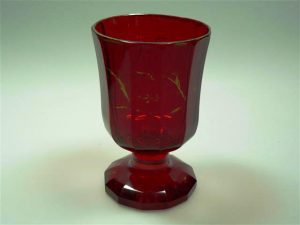Böhmisches Glas: Goldrubinglas – Deutsch/German

Im 18. Jahrhundert erfanden böhmische Glasmacher das Kreideglas. Damit wurde das dünne und leicht zerbrechliche cristallo-Glas aus Venedig abgelöst. Das dickwandige, klare Kristallglas eignete sich hervorragend für die in Mode gekommenen, farbig überfangenen Gläser. Ebenso für die neuen Glasveredelungstechniken wie Glasschliff und Glasschnitt. Die hohe Lichtbrechung und Brillanz des Glases war geradezu ideal, um an den Fürstenhöfen Europas das Bedürfnis nach Macht und Glanz zu repräsentieren.
Besonders begehrt war es seit Beginn der Glasherstellung, ein rotes durchscheinendes Glas herzustellen. Als Vorbild nahmen die Glasmacher den roten Rubin-Edelstein, den „Karfunkel“. Der im 13. Jahrhundert lebende Albertus Magnus hielt ihn für den edelsten Stein, weil seine Kraft „jener der Sonne ähnlich sei und sogar im Finstern wie Kohle zu glühen vermochte.“
Die Schwierigkeit rotes Glas herzustellen, lag in der genauen Zusammensetzung der Glasmasse und der Regelung des Feuers beim Anlaufprozess. Um 1680 gelang es dem berühmten Glasmacher Johann Kunckel in Potsdam ein mit Gold hergestelltes, durchscheinend rotes Glas zu schmelzen – das kostbare Goldrubinglas. Bis heute sind solche Gläser absolute Raritäten. Denn nur wenige Glashütten waren in der Lage, Goldrubingläser zu fertigen. Und die wenigen erhaltenen Exemplare sind heute von unschätzbarem Wert.
Übrigens sind nur maximal 0,03 Prozent Gold nötig, um aus einem zunächst farblosen Glas durch nochmaliges Erwärmen eine purpurrote durchscheinende Glasfarbe zu erzeugen.
Bohemian Glass: Cranberry / Gold Ruby Glass – English

During the 18th century Bohemian glassmakers discovered chalk glass and it replaced the thin and fragile Cristallo Glass from Venice. The thick-walled, clear crystal glass was perfectly suited for glass overlaid with colour that had just come into fashion and likewise for the glass-finishing techniques of cutting and polishing. The high level of light refraction and brilliance of the glass was the perfect representational medium for European courts to demonstrate their power and splendour.
The creation of a red translucent glass was especially coveted since glass production began and glassmakers adopted the red ruby „carbuncle,“ as their role model. Albertus Magnus, who lived in the 13th century, regarded it as the most precious stone of all, because its power was „similar to that of the sun and the stone was even capable of glowing like coal in the dark.“
The difficulty in producing red glass lay in the exact composition of the glass mass and the control of the fire during initial processing. In Potsdam around 1680 the famous glassmaker Johann Kunckel was able to smelt a red glass that contained gold – the needless to say – valuable, cranberry, or gold ruby glass. This glass is an absolute rarity even today because so few glass foundries were capable of producing cranberry glass and the few examples that still exist are extremely valuable.
If colourless glass is re-heated, only 0.03 per cent of gold is required to turn it into a crimson-red translucent glass, by the way.